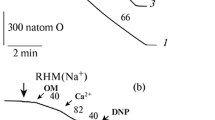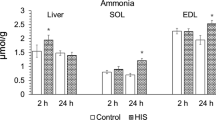Summary
The effect of either extracellular sodium or extracellular celoride reduction on the release of endogenous noradrenaline and its deaminated metabolite dihydroxyphenylglycol (DOPEG) has been studied in the isolated perfused rat heart under conditions of ischaemia and cyanide intoxication. The overflow of noradrenaline and DOPEG was determined by high pressure liquid chromatography. The efflux of DOPEG, the predominant neuronal noradrenaline metabolite, served as indicator of the free axoplasmic amine concentration. A calcium-free perfusion buffer was used to avoid exocytotic noradrenaline release. Sodium and chloride in the perfusion buffer were replaced by lithium and isethionate, respectively.
(1) Reduction of extracellular sodium or chloride increased noradrenaline overflow in ischaemia. The release was suppressed by the uptake, blocker cocaine indicating carrier-mediated outward transport of noradrenaline. (2) In cyanide intoxication sodium or chloride reduction accelerated the onset of DOPEG efflux reflecting increased axoplasmic noradrenaline concentrations. This was accompanied by increased noradrenaline release. The ratio of noradrenaline/DOPEG overflow was increased by reduced sodium or chloride, indicating facilitation of carrier-mediated noradrenaline net outward transport. (3) In the presence of unaltered energy metabolism overflow of both, noradrenaline and DOPEG, was not enhanced by sodium or chloride reduction.
The results demonstrate that reduction of extracellular sodium or chloride has two effects on noradrenaline release from the sympathetic neuron with reduced energy supply. First, reduced sodium or chloride induces increased axoplasmic noradrenaline concentrations by interference with vesicular storage function. Second, both interventions enhance carrier-mediated noradrenaline release.
Similar content being viewed by others
References
Beers MF, Carty SE, Johnson RG, Scarpa A (1982) H+-ATPase and catecholamine transport of chromaffin granules. Ann NY Acad Sci 402:116–133
Bönisch H, Langeloh A (1986) Neuronal efflux of noradrenaline induced by tris or lithium as substitutes for extracellular sodium. Naunyn-Schmiedeberg's Arch Pharmacol 333:13–16
Bönisch H, Fuchs G, Graefe KH (1986) Sodium-dependence of the saturability of carrier-mediated noradrenaline efflux from noradrenergic neurones in the rat vas deferens. Naunyn-Schmiedeberg's Arch Pharmacol 332:131–134
Carlsson L, Abrahamsson T, Almgren O (1986) Release of noradrenaline in myocardial ischemia — importance of local inactivation by neuronal and extraneuronal mechanisms. J Cardiovasc Pharmacol 8:545–553
Carlsson L, Graefe KH, Trendelenburg U (1987) Early intraneuronal mobilization and deamination of noradrenaline during global ischemia in the isolated perfused rat heart. Naunyn-Schmiedeberg's Arch Pharmacol 336:508–518
Casey RP, Njus D, Radda GK, Sehr PA (1976) Adenosine triphosphate-evoked catecholamine release in chromaffin granules: Osmotic lysis as a component of proton translocation. Biochem J 158:583–588
Dart AM, Riemersma RA, Schömig A, Ungar A (1987) Metabolic requirements for release of endogenous noradrenaline during myocardial ischemia and anoxia. Br J Pharmacol 90:43–50
Friedrich U, Bönisch H (1986) The neuronal noradrenaline transport system of PC-12 cells: Kinetic analysis of the interaction between noradrenaline. Na+ and Cl− in transport. Naunyn-Schmiedeberg's Arch Pharmacol 333:246–252
Graefe K-H, Zeitner C-J, Fuchs G, Keller B (1984) Role played by sodium in the membrane transport of 3H-noradrenaline across the axonal membrane of noradrenergic neurones. In: Fleming WW, Graefe K-H, Langer SZ, Weiner N (eds) Neuronal and extraneuronal events in autonomic pharmacology. Raven Press, New York, pp 51–62
Johnson RG, Pfister D, Carty SE, Scarpa A (1979) Biological amine transport in chromaffin ghosts. Coupling to the transmembrane proton and potential gradients. J Biol Chem 254:10963–10972
Johnson RG, Carty SE, Scarpa A (1981) Proton: Substrate stoichiometries during active transport of biogenic amines in chromaffin ghosts. J Biol Chem 256:5773–5780
Langendorff O (1895) Untersuchungen am überlebenden Säuge-thierherzen. Arch Ges Physiol 61:291–332
Maron R, Stern Y, Kanner B, Schuldiner S (1983) Functional assymmetry of the amine transporter from chromaffin granules. J Biol Chem 258:11476–11481
Paton DM (1973) Mechanism of efflux of noradrenaline from adrenergic nerves in rabbit atria. Br J Pharmacol 49:614–627
Phillips JH (1977) Passive ion permeability of the chromaffin-granule membrane. Biochem J 168:289–297
Phillips JH (1982) Dynamic aspects of chromaffin granule structure. Neuroscience 7:1595–1609
Sammet S, Graefe KH (1979) Kinetic analysis of the interaction between noradrenaline and Na+ in neuronal uptake: evidence for co-transport. Naunyn-Schmiedeberg's Arch Pharmacol 309:99–107
Sanchez-Armass S, Orrego F (1977) A major role for chloride in (3H)-noradrenaline transport by rat heart adrenergic nerves. Life Sci 20:1829–1838
Sanchez-Armass S, Orrego F (1978) Noradrenaline transport by rat heart sympathetic nerves: a re-examination of the role of sodium ions. Naunyn-Schmiedeberg's Arch Pharmacol 302:255–261
Schömig A, Dart AM, Dietz R, Mayer E, Kübler W (1984) Release of endogenous catecholamines in the ischemic myocardium of the rat. Part A. Locally mediated release. Circ Res 55:689–701
Schömig A, Fischer S, Kurz T, Richardt G, Schömig E (1987) Nonexocytotic release of endogenous noradrenaline in the ischemic and anoxic rat heart: Mechanism and metabolic requirements. Circ Res 60:194–205
Schömig A, Kurz Th, Richardt G, Schömig E (1988) Neuronal sodium homeostasis and axoplasmic amine concentration determine calcium-independent noradrenaline release in normoxic and ischemic rat heart. Circ Res 63:214–226
Schömig E, Trendelenburg U (1987) Simulation of outward transport of neuronal 3H-noradrenaline with the help of a two-compartment model. Naunyn-Schmiedeberg's Arch Pharmacol 336:631–640
Stute N, Trendelenburg U (1984) The outward transport of axoplasmic noradrenaline induced by a rise of the sodium concentration in the adrenergic nerve endings of the rat vas deferens. Naunyn-Schmiedeberg's Arch Pharmacol 327:124–132
Trendelenburg U, Bönisch H, Graefe K-H, Henseling M (1980) The rate constants for the efflux of metabolites of catecholamines and phenethylamines. Pharmacol Rev 31:179–203
Winkler H, Apps DK, Fischer-Colbrie R (1986) The molecular function of adrenal chromaffin granules: Established facts and unresolved topics. Neuroscience 18:261–290
Author information
Authors and Affiliations
Additional information
This work was supported by the Deutsche Forschungsgemeinschaft (SFB 320)
Send offprint requests to A. Schömig at the above address
Rights and permissions
About this article
Cite this article
Kurz, T., Schömig, A. Extracellular sodium and chloride depletion enhances nonexocytotic noradrenaline release induced by energy deficiency in rat heart. Naunyn-Schmiedeberg's Arch Pharmacol 340, 265–269 (1989). https://doi.org/10.1007/BF00168508
Received:
Accepted:
Issue Date:
DOI: https://doi.org/10.1007/BF00168508




